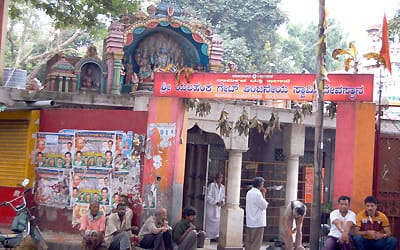An early morning walk in Kempegowda’s pettah would not sound welcoming to most Bengaluru folks. But thanks to Poornima Dasharathi’s insight, the Pettah Walk turned out to be a comprehensive introduction to Bengaluru’s beginnings.

Yelahanka Gate Anjaneya temple.
Pic: Poornima Dasharathi
We were scheduled to meet up at 7am near the Anjaneya temple, Mysore Bank Circle. I got there 20 minutes late and was touched that Poornima and the team of enthusiasts were waiting for me near Cauvery Bhavan.
We started off by briefly introducing ourselves. Poornima traced Kempegowda’s family from Yelahanka and beyond and provided historical reasons for Bengaluru’s location and name. As I imagined the erstwhile fort through Poornima’s words, I started appreciating Kempegowda’s sagacity to establish a trading center, similar to one at Hampi where trading of agricultural goods to gems and jewels could take place. We visited the 500 year old Anjaneya temple at the Yelahanka gate of the erstwhile fort, saw the Rice Memorial Church built in memory of the early Christian missionary and later visited the Ranganatha Swamy Temple where a inscription validated the supremacy that Kempegowda’s Bengaluru enjoyed in the region.
Left- Ranganatha Temple. Right- Chasing landscapes
Pic: Poornima Dasharathi
The walk culminated with a sumptuous breakfast of Benne Masala Dosa and Coffee at Sri Udupi Krishna Bhavan on Balepete main road. It was a pleasant surprise when we were told that the breakfast was sponsored by Citizen Matters. Meeting like-minded fellow enthusiasts added to the pleasure of the walk.
Thank you Poornima and Citizen Matters.⊕


Excellent article. And its important that your points are so nuanced. Its a fine balance between understanding the value of money, and turning extremely materialistic on the other hand. Nowadays we see typical double income, IT couples who seem to indulge in every whim of their child. Mostly because they are enjoying the sensation of just being able to do the best for their children. But the side effect is that some children completely miss the reality that things have proportional value, and you need to work to earn certain things in life. Introducing them early to a balanced view of value and earning is simply practical and useful. To my mind it ranks up there, with all the reality of life how to be prepared discussions. Great to see you articulate it so well.